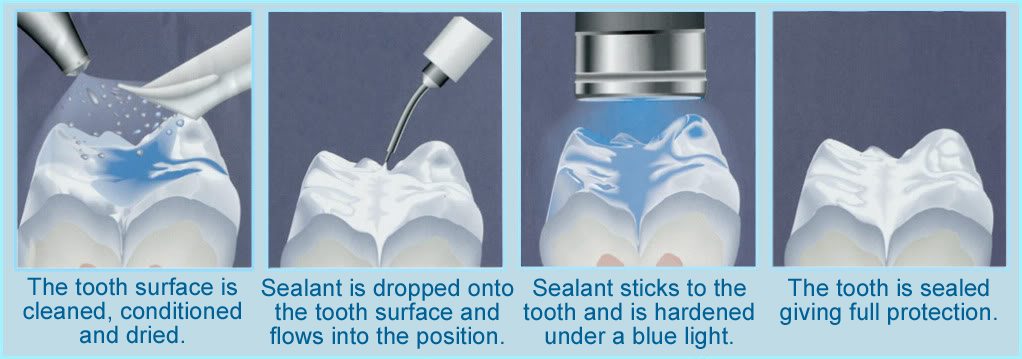The pits and grooves of your teeth are prime areas for opportunistic decay. Even regular brushing sometimes misses some of these intricate structures on the chewing surfaces of your teeth.
Dental Sealants are a safe and painless way of protecting your teeth from decay. A sealant is a protective plastic coating, which is applied to the biting surfaces of the back teeth. The sealant forms a smooth, protective shield that stops food and bacteria getting into the tiny grooves in the teeth and causing decay. Even regular brushing sometimes misses some of these intricate structures on the chewing surfaces of your teeth.
The chewing surfaces of the molar and premolar teeth have grooves — “fissures” — that make them vulnerable to decay. These fissures can be deep, are difficult to clean, and can be narrower than even a single bristle of a toothbrush. Plaque accumulates in these areas, and the acid from bacteria in the plaque attacks the enamel and cavities can develop.
Fluoride helps prevent decay and helps protect all the surfaces of the teeth, dental sealants provide extra protection for the grooved and pitted areas by providing a smooth surface covering over the fissured area.

What do dental sealants look like?
Dental sealants can be clear, white or have a slight tint depending upon the dental sealant used.
How are dental sealants placed?
Sealants are applied by first cleaning the tooth surface. Next the tooth is washed with water and dried. Then a solution that is acidic is placed on the fissured area of the tooth’s chewing surface for a number of seconds before being rinsed off. This creates small microscopic areas and a fine rougher surface than the surrounding tooth enamel that can be seen with a microscope. The rough surface and microscopic areas enable the dental sealant to attach to the
After the tooth is dried again, the liquid dental sealant is placed on the tooth and hardened. Dental sealants are hardened by using a light that hardens the dental sealant, or sometimes by using a two-component dental sealant that sets without using a light. Once the dental sealant has hardened it becomes a hard plastic varnish coating, and you can chew on the tooth again.
How long does a tooth sealant last?
Dental sealants have been used and have been proven to be effective since the 1980s. Many studies have shown that they are effective in helping to prevent decay on chewing (occlusal) surfaces. Dental sealants can last many years. If necessary, it is also possible to place a new dental sealant on the tooth.
Do I still need to use fluoride if I have dental sealants?
Yes. Dental sealants only protect the surface area that they are placed on. Fluoride helps protect all the surfaces of the tooth from decay and cavities.
